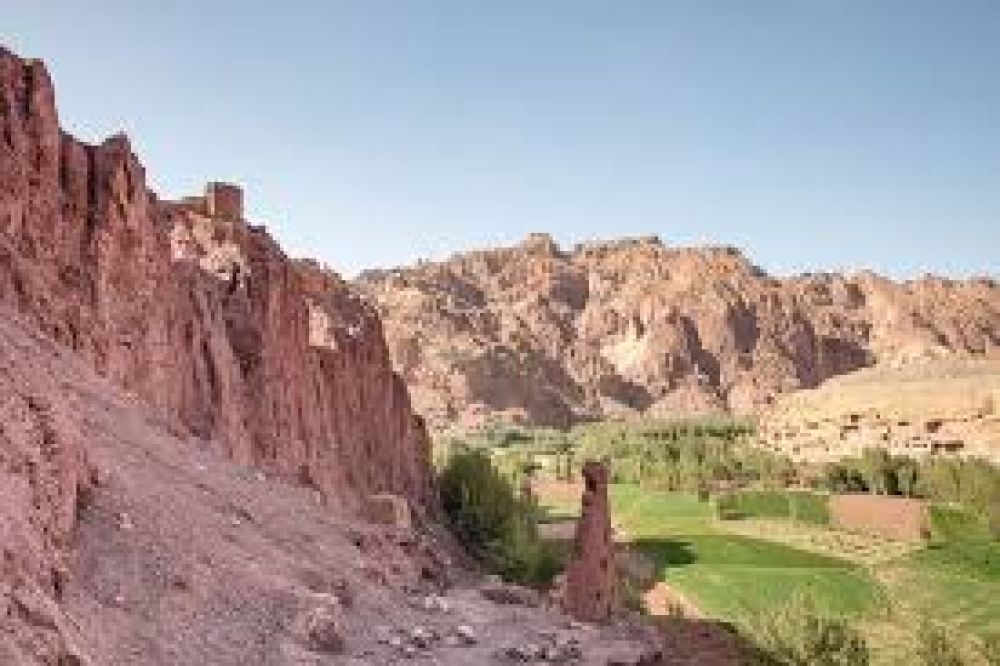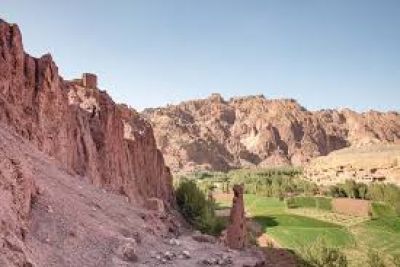

Bamyan, renowned for its cultural significance and ancient historical sites, offers an awe-inspiring exploration experience. Visitors can delve into the history of the once-majestic Bamyan Buddhas, which stood as monumental statues carved into the side of a cliff before their destruction. Although they no longer exist in their original form, the niches and the remnants hold deep cultural and historical value, reminding visitors of the region's rich Buddhist heritage. Tourists can also explore the UNESCO-listed Cultural Landscape and Archaeological Remains of the Bamyan Valley, which encompasses numerous monastic ensembles and sanctuaries as well as the remains of Bamiyan's Islamic architecture. An experienced guide can provide comprehensive insights into the historical context and significance of the various sites, making for an enriching educational experience. The visit generally includes the Shar-e-Gholghola (City of Screams), an ancient fortress at the peak of a hill offering a panoramic view of the entire valley.
Afghanistan's first national park, Band-e-Amir, is a natural paradise comprising a series of six deep blue lakes separated by natural dams of travertine, a form of limestone. The Park is located approximately a two-hour drive from Bamyan city. The area is known for its stunning, ethereal landscapes and clear waters that reflect the surrounding cliffs and sky. A hiking trip here involves not only witnessing the incredible color contrasts of the lakes against the barren landscape but also the chance to observe local wildlife. The trail provides varying levels of difficulty to cater to both experienced hikers and casual walkers. Along the way, visitors can learn about the unique geological processes that continue to shape these natural dams. Band-e-Amir is an excellent spot for a picnic, photography, and immersing oneself in the tranquil beauty of Afghanistan's countryside.
Historically known as the gateway to the Buddha statues, the Waras District in the Bamyan province now serves as a living testament to the resilience of the Afghan people. When visiting Waras, tourists are taken through the winding roads that reveal the true rural life of the highland dwellers. Here one can witness traditional farming methods, small cottages built from mud and straw, and a lifestyle relatively untouched by modern complexities. The district is also home to various historic and archaeological sites, including ancient Buddhist monasteries carved into the sides of cliffs and scattered remains that hint at the complex history of the region. A visit to the local bazaar offers a vibrant immersion into the hustle and bustle of daily commerce, where one can find traditional handicrafts, textiles, and spices that are characteristic of local culture.
The fascinating cave dwellings carved into the cliffs of the Bamyan Valley are a remarkable feature that visitors can explore. These caves were home to monks and hermits for centuries and were once part of a large Buddhist monastery complex. The interiors of some of these caves feature remnants of wall paintings and inscriptions, providing a glimpse into the daily life and spiritual practices of the inhabitants. Exploring these caves offers an unique opportunity to understand the blend of history, religion, and art that characterized the region's past. As some of the caves are located near the site of the destroyed Buddhas, they can be incorporated into a comprehensive tour of the historical area. It's recommended to carry a flashlight and wear sturdy shoes for this activity, as the terrain can be uneven and dark inside the caves.
Discover the culinary delights of Bamyan by sampling local Afghan cuisine, which is a tantalizing blend of flavors influenced by Central Asian, South Asian, and Middle Eastern cuisories. Dining experiences in Bamyan often include dishes such as 'kabuli pulao,' a deliciously seasoned rice dish with carrots, raisins, and typically lamb; 'mantu,' which are steamed dumplings filled with minced meat and topped with yogurt and tomato sauce; and 'ashak,' scallion-filled dumplings covered in meat sauce and yogurt. For the more adventurous palate, there's the opportunity to try 'shor nakhod,' a salad made from chickpeas mixed with various spices and topped with yogurt. Visiting a local teahouse is also a must, where one can enjoy 'chai' (tea) and traditional sweets while mingling with locals. This activity is perfect for food lovers eager to explore the region's culture through its cuisine.
Bamyan is not only a place of historical wonders, but also a rich center for traditional crafts. One of the most noteworthy is the art of carpet weaving, an activity deeply rooted in Afghan culture. Travelers can visit local workshops where they will see skilled artisans at work, creating intricate designs that are known worldwide for their beauty and quality. The process involves spinning the wool, dyeing it with natural or synthetic colors, and then weaving it into vibrant patterns on a loom. Participants in these workshops can learn about the different symbols, motifs, and techniques used in Afghan rug making. Some workshops may even offer hands-on experiences, allowing guests to try their hand at weaving under the guidance of a master weaver. This unique experience not only supports local artisans but also offers an opportunity to gain insight into a vital aspect of Afghan heritage.
Photography enthusiasts and professionals alike will find Bamyan's landscape to be an absolute paradise for capturing stunning images. Ranging from rugged mountain terrains and peaceful valleys to historical ruins and vibrant local communities, there is no shortage of captivating subjects. A guided photography tour can help participants find the best locations and times of day for capturing the perfect shot. The guidance of a local expert can also provide insights into the cultural context and significance of the chosen scenes. These tours may include sunrise or sunset sessions at the Buddha cliffs, capturing the interplay of light and shadows on the ancient carvings, or visits to remote villages to document daily life and traditional customs. Participants should be prepared with their camera equipment and be ready to traverse diverse terrains for those irreplaceable shots.
Experience the distinctive landscape of Bamyan in a unique and exciting way by embarking on a yak safari through the highlands. Yaks are native to the region and have been used by the local population for centuries for transportation and as pack animals. Tourists can ride on these gentle giants, led by local herders, and explore the rugged terrain, which provides breathtaking views of the surrounding mountains and valleys. This eco-friendly mode of travel allows for a leisurely pace, making it possible to fully appreciate the environment without the noise and rush of motorized transport. The yak safari also includes learning about the lifestyles of the nomadic Kuchi people, who migrate with their livestock in search of pasture, and observing wildlife that may not be easily accessible by foot or vehicle. It's an adventurous way to engage with the unique culture and geography of this part of Afghanistan.
Gholghola, known as the City of Screams, is an ancient fortress dating back to the middle of the 6th century and carries with it a haunting history of destruction by Genghis Khan. The ruins are situated on a hill overlooking the Bamyan valley and provide an intriguing visit for those interested in Afghanistan's bygone eras. A trek to Gholghola presents an opportunity to wander among the remnants of walls, gates, and structures while contemplating the stories of those who once inhabited the city. As you make your way to the top, the breath-taking panoramic views of the surroundings serve as a stark contrast to the somber history of the site. Visitors are taken on a journey through time, as guides explain the architectural elements, strategic positioning, and historical context of this once-thriving fortress city.
Darya Ajdahar, also known as the Dragon Valley, lies not far from the town of Bamyan and is a place steeped in local folklore and legends. The valley gets its name from a mythological dragon said to have been slain by the Hazara hero, Hazrat Ali, and features a rock formation resembling a serpentine creature. In addition to its mythical allure, the valley offers an impressive geological display of sedimentary rock formations, eroded into unique shapes over millennia. A visit to Darya Ajdahar is an invitation to let the imagination wander through myth and nature. It is an excellent location for hiking where visitors can enjoy a leisurely walk through the valley, discover local flora and fauna, and of course, marvel at the dragon-like rock structures that give this place its name. The Dragon Valley offers a perfect blend of natural beauty and cultural storytelling, catering to both the adventurous and the curious.
